The 2024 Grain Season - Timely rain hits most of the West Australian grain growing regions
Rain during the start of July has reached most grain growing regions of Western Australia with falls of 15mm or more for all areas except parts of the southern grain growing regions and the western portions of the Esperance port zone. The northern grain growing zones received well in excess of this.
Many crops were on a knife-edge at the end of June with little or no sub-soil moisture reserves and the rain could not have come sooner. Crops were starting to show signs of moisture stress from the dry warm June and were getting to a point where grain yield potential may have been difficult to recover.
Crops across the state now look deceptively fresh and in general have reasonable grain yield potential. Rainfall deciles are low or very low for all areas of the state and it is going to need to be a good year from here on in to hit the current potential of 15-16 million tonnes of total grain for Western Australia.
Cereals are in better condition than the break crops which have suffered more from the late start and patchy June rainfall. Canola and lupin grain yields will be at the lower end of long-term averages for their regions.
The total crop area in the state is up from 2023 plantings and the area of canola is down, replaced by wheat. The oat area has increased in the traditional oat growing regions, although there is little change elsewhere. The lupin area is down again this year to 20-year lows, and pulse crop area is insignificant in the scheme of things.


Seasonal Outlook
Ian Foster, Department of Primary Industries and Regional Development

Climate summary
Seasonal climate June 2024
Rainfall
After a prolonged very dry and hot summer, late May and early June saw a welcome start to the growing season. Tropical interaction has brought very good rainfall for the northern cropping area, however, much of the southern and eastern cropping area recorded below average June rain. Rainfall over April to June remains much lower than normal for the cropping area apart from the north (see Figure 1). Soil moisture storage is low in these areas (see Figure 2).
Forecast
Climate conditions in the Indian and Pacific Oceans are neutral. Chances are rising for the development of a La Nina event, but models are not all in agreement. The Indian Ocean Dipole is likely to remain neutral.
The Bureau of Meteorology’s seasonal outlook for July to September has neutral rainfall chances for much of the cropping area. Many of the international climate models also have a neutral outlook for this period. Most models had a below normal rainfall outlook at the same time in 2023.
The dry start to the growing season for many areas means above median rain is needed for the rest of the season to make the historical average growing season rain. In Figures 3 to 6, cumulative rain is shown against historical percentiles for selected locations. They enable comparison between rainfall received and historical records and provide some context to the current season and how it’s tracking.
The purple line shows current rainfall received. Extending out from the solid purple line are three light blue lines, which represent a range of historical finishes (dry, average or wet) to the season from the current date onwards.
The contrast in seasonal conditions between north and south is marked, with Binnu tracking very wet, compared with Merredin and Esperance. These locations require well above average rain for the rest of the season to make average. Good rain in June has brought Kojonup up to near normal for season to date.
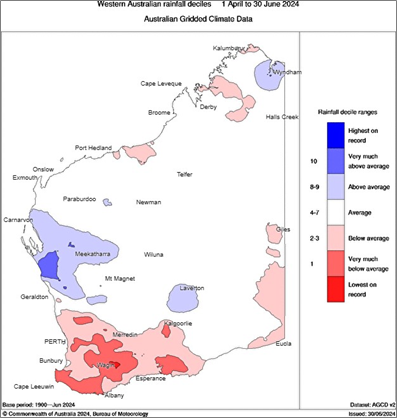
Figure 1: Rainfall deciles for April to June 2024. Source: Bureau of Meteorology (2024).
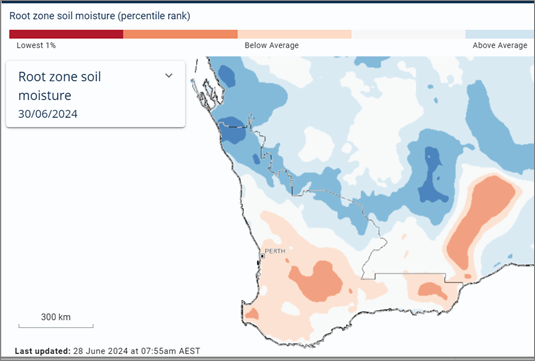
Figure 2: Estimated root-zone soil water percentiles at 30 June 2024. Source: Bureau of Meteorology (2024).
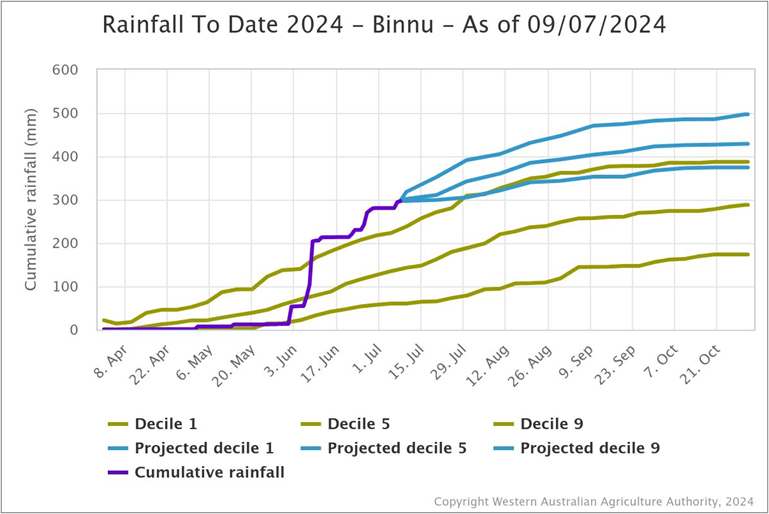
Figure 3: Cumulative rainfall from 1 Apr to 9 July 2024 at Binnu. Source: DPIRD
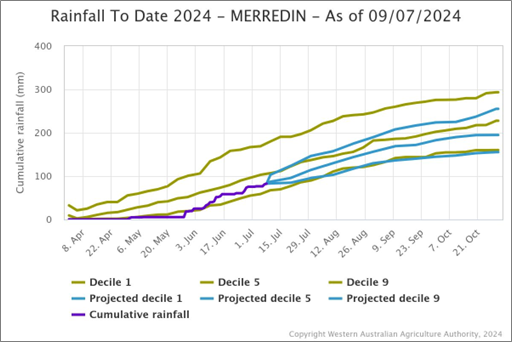
Figure 4: Cumulative rainfall from 1 Apr to 9 July 2024 at Merredin. Source: DPIRD
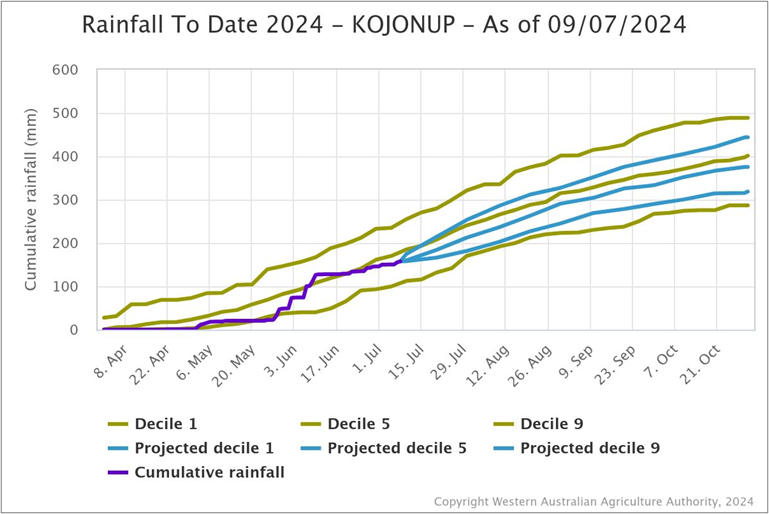
Figure 5: Cumulative rainfall from 1 Apr to 9 July 2024 at Kojonup. Source: DPIRD
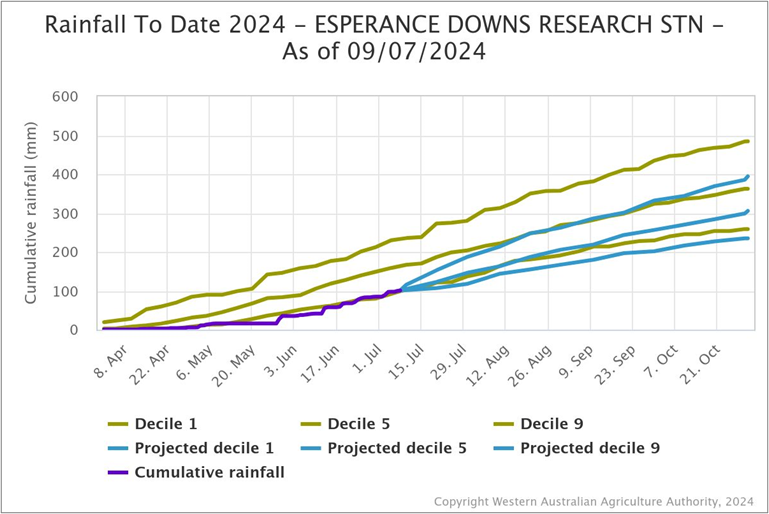
Figure 6: Cumulative rainfall from 1 Apr to 9 July 2024 at Esperance Downs Research Station. Source: DPIRD
Temperature
Seasonal temperatures over autumn have been very much above normal.
Predictions of above normal temperatures continue through winter and spring. Chances of unusually high temperatures remain elevated over historical records.
Additional information is available from:
BoM: Decile rainfall for April to June 2024
BoM: Rainfall outlook for the next week
BoM: Seasonal Rainfall Outlook
Geraldton Zone
The Geraldton zone has swung from famine to feast in the space of a month, with many growers planning for the worst, to some areas now too wet to be trafficable. The transformation has been incredible and once the hot dry winds made way for rain in June, the region is now on track for a good year.
There was a lot of holding back on the break crops in April and May with the area sown down a long way from that of a normal year. The area of country that was destined for fallow in May ended up being sown to wheat and the large areas of fallow from 2023 have all gone into crop. This has resulted in a large crop planting for the region.
Kwinana Zone
Kwinana North Midlands
Rain over the last week or so has come just in the nick of time as crops were wilting from the warm dry conditions in June, particularly in the central portions of the zone. The west coastal regions have picked up some good falls of rain and many areas have now had more than 200mm for the year. The nitrogen use efficiencies on these lighter soils should be very good, as there has not been the usual heavy leaching rains to date.
The low rainfall eastern portion of the zone from Latham down to Burakin has improved dramatically and now has rainfall totals well in excess of the dry central regions of the zone from Watheroo through to Bindi Bindi and down to Wongan Hills. Whilst the eastern fringe of the zone has sub-soil moisture reserves from autumn storms, the remainder of the zone has no buffer whatsoever and will need a good run from now on to hit long term average grain yields.
Canola and lupin crops are generally poor across all regions of the zone.
Kwinana South
Crops were on a knife-edge up until a week or two ago with many starting to show the effects of moisture stress. The several light rainfall events recently have given crops a lift and those that did jag double digit totals now look fresh and back on track for reasonable grain yields closer to 10-year averages rather than recent averages. All crops are behind where you would like them to be for this time of the year and the rain is going to have to keep coming for them to hit long term average grain yields.
The dry strip that runs from the central Midlands region continues down through the central and western Kwinana South zone, and while crops look ok now, there are no sub-soil moisture reserves apart from in a few spots around Brookton and Corrigin, which received rain from some of the storms in autumn.
The break crops are quite mixed with many very ordinary canola and lupin crops in the region. The late start and dry June have had a big impact, and many will struggle to make up enough ground now to reach profitable yields.
Kwinana North East
The low rainfall regions of the Kwinana zone have recently been receiving the rain that has evaded the western regions, and crops north of the Great Eastern Highway and east of Merredin have improved dramatically with some areas now nudging 200mm of rain for the year. Most areas have had 150mm and even though the crops are later than normal, the cereal crops have reasonable grain yield potential.
Canola and lupin crops are well behind where they need to be to hit average grain yields. Recent rain has helped push them along, although the late start for those that missed out on the rain in April means their top end potential will be limited, and those that did get up and away early are patchy and unlikely to improve enough to hit profitable yields.
Albany Zone
Albany West
The crops in the Albany West region are looking good at the moment, although there is no moisture in the bank. Most areas have less than 25mm of soil available moisture, which is only enough for the next few weeks. To hit average grain yields, another 200mm of rain is going to be needed. The region has a wide spread in crop growth stages. The canola and cereals that came up in April and early May look very good, but the later emerging crops are well behind, and now with the cold weather setting in, the brakes have gone on growth.
Rainfall totals drop off in the eastern portions of the zone and the crop quality reflects this.
Albany South
The majority of crops in the region look good considering the lack of sub-soil moisture in the profile and how late they emerged. Crops on the heavier soils have struggled with the lack of rain and persistent warm temperatures. Many portions of the zone have had barely 100mm of rain for the year so far and will need a good spring to hit reasonable grain yields. Even though growers have held back on planned nitrogen applications due to the prospects of a below average year from the lack of rain, there is still time for the season to turn around if there are good spring rains.
Albany East (Lakes Region)
After a reasonable start, the prospects for an average year have slipped away for crops in the region. The recent rain has been light for the areas east of Highbury across to Newdegate and south to Nyabing and north of the ranges and east to Ravensthorpe. Some areas have faired better than others although there are not many rainfall totals above 150mm for the year right across the zone.
Most growers have shut the gate on the season and are cutting back on nitrogen for the moment and hoping for the rain to pick up in July.
Esperance Zone
Grain yield potential on the west side of town continues to be in front of crops to the east, and even though areas along the coast have picked up, it is still very patchy across the zone. Several rainfall events in June gave the dry sown crops a chance to emerge, particularly in the eastern areas. Crop growth stages are quite varied and whilst crops in the western portions have reasonable grain yield potential, those in the east are running out of time to make up ground to achieve average grain yields.
Crops in the region look better than the moisture profile suggests, as they do across much of the state, and will need a good spring to achieve their current potential. There have been a few insect issues which is often the case when crops are stressed, and the very warm winter to date has contributed to a few more issues with bugs than normal.